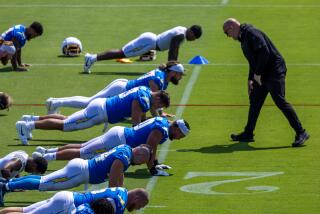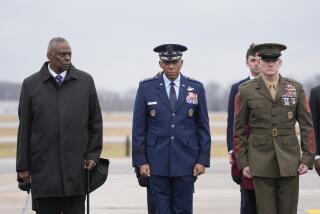Strikes Aim to Knock Out Terrorists’ Training Camps
- Share via
WASHINGTON — A network of training camps operated by Osama bin Laden was among the prime targets of Sunday’s air attacks, even though most of them were believed to have been evacuated in recent weeks, officials said.
The reason: The camps provide the suspected terrorist leader with convenient nighttime hiding spots, as well as a place to store communications equipment, ammunition and other supplies.
“We want to keep him on the run,” said one administration official, adding that the military strikes were partly symbolic, providing a very visual assault on the physical infrastructure of Bin Laden’s terrorist network.
Intelligence officials have said that Bin Laden oversees about two dozen camps. Some are large and sophisticated, equipped with barracks, storage complexes, target ranges and obstacle courses. Others are smaller, spartan redoubts clustered around caves or even hidden deep underground.
And despite the best estimates of the CIA and the National Security Agency, officials conceded that it is virtually impossible to tell which of the camps Bin Laden might be hiding in at any time. He is believed to move from one to another on a moment’s notice, often staying in one place for a night at most.
Even so, experts said, the Bush administration’s military planners were smart in trying to knock out the camps--particularly those in and around Kandahar, which is believed to be Bin Laden’s spiritual and administrative headquarters, as well as a base of operations for the Taliban regime.
“They don’t have any illusions that they will kill him by bombing a cave or a training site,” said Vincent Cannistraro, a former CIA counter-terrorism chief. “They are trying to flush him out, make him move from one camp to another so they can get a fix on him. Moving around will make it difficult for him to stay on top of his network and to communicate with them and give guidance.”
The camps form the backbone of Bin Laden’s network. Over the last 10 years, officials said, they have provided training to thousands of jihad warriors who have come from around the world to learn basic guerrilla techniques and more advanced forms of terrorism.
Convicted terrorist Ahmed Ressam described the camps in chilling detail three months ago, when he testified in a federal courtroom about how he spent seven months in 1998 at a basic training site and then an advanced training facility.
Ressam said he and dozens of other militants from Algeria, Yemen, Jordan and even Sweden learned strategies and methods for conducting terrorist attacks against American targets--from U.S. embassies, warships and military installations to tourist sites abroad, hotels, airports and power grids.
Ressam also said he was given instructions in how to assassinate political leaders and spread poison through government buildings.
U.S. officials have said that some of the hijackers in the Sept. 11 attacks are believed to have trained in the camps, as are those suspected of bombing the U.S. destroyer Cole last year and destroying two American embassies in Africa in 1998.
The United States launched military strikes at the camps after the embassy bombings in a failed attempt to kill Bin Laden and some top commanders.
In the last two years, it has been hard for intelligence analysts to get a good fix on the camps, authorities conceded.
As the United States’ satellite imagery has improved, Bin Laden and his top commanders in the Al Qaeda terrorist network have reacted by using disinformation and bait-and-switch tactics to hide the actual location of many facilities. In some cases, they have shifted them to mountain caves of the Oruzgan province near the main road from Kandahar in southeast Afghanistan to the capital of Kabul.
That means many of the cruise missiles fired by the U.S. military may never find their targets, unless military personnel on the ground place homing beacons close to them, terrorism expert Steven Emerson said.
“But nobody knows. Maybe they’ll get lucky and get him,” Emerson said. “If not, they’ll probably take out some of his equipment.”
More to Read
Sign up for Essential California
The most important California stories and recommendations in your inbox every morning.
You may occasionally receive promotional content from the Los Angeles Times.










